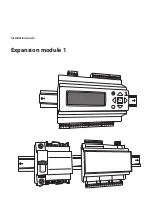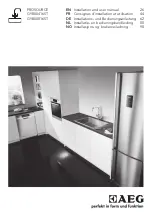
When reassembling ensure the sealing washer located in the
union nut is replaced. If the washer is damaged it must be
replaced.
Ensure the sealing grommets are fitted correctly and seal the
inner casing.
13.4 SERVICING OF COMPONENTS
Clean the Fan
Any dust or fluff should be removed with a soft brush or by
blowing. Take care not to distort the pressure sensing device.
Clean the Burner
Brush the blade tops and mixing tube with a soft brush and
check that all the flame ports arc clear. Remove any blockages
with a non-metallic brush. Inspect the injector and clean with a
soft brush. Replace the injector if it appears damaged. Do not use
a wire brush or anything likely to cause damage. Replace the
spark and sense electrodes if they appear damaged.
Clean the Gas to Water Heat Exchanger
Cover the burner manifold hole in the inner casing bottom panel
with a cloth. Clean the heat exchanger using a soft brush.
Remove the deposits from the bottom of the combustion
chamber. The heat exchanger is manufactured from copper take
care not to distort any of the fins.
Secondary Heat Exchanger
The secondary heat exchanger is located at the rear of the inner
casing housed in a sealed stainless steel box. It is a non-
serviceable component. See figs. 32 and 43.
Should a fault occur with the secondary heat exchanger
requiring a replacement the heat exchanger can be removed
from the inner casing and a replacement fitted.
Refer to Section 14. Replacement of parts, Item 25.
Combustion Chamber Insulation
Examine and replace any pads that are damaged. Remove any
dust or deposits using a soft brush.
Re-assemble the Appliance in the Reverse Order
Check that all components are in place and correctly fixed. Leave
the cabinet front panel to be fitted after checking the operation
of the appliance.
Condensate Syphon
The condensate Syphon is located under the inner casing behind
the gas valve. The syphon is manufactured from transparent
material and must be visually inspected for blockage. If the
syphon is blocked it must be removed for cleaning,
ref. Section 14.3 (26).
13.5 TEST THE APPLIANCE
On completion of the service and re-assembly of the appliance,
check for gas soundness and the correct operation of the
appliance as described in Section 11 - Commissioning. Refit the
cabinet front panel and reset the controls to the users
requirements.
WARNING:
Switch off the electricity and gas supplies before replacing any
components. After the replacement of any components, check
for gas soundness where relevant and carry out functional
checks as described in Section 11 - Commissioning.
14.1 COMPONENT ACCESS
To replace components it is necessary to remove one or more
sections of the cabinet and cover plates within the appliance as
described in Section 13.3. The facia panel will also require to be
hinged down, as described in Section 13.3 (c).
IMPORTANT:
The following components are secured to the appliance with
clips, wire clips, screws, union fittings or ‘O’ ring seals to ensure
the joints are sound.
See figs. 32 and 37.
Automatic air vent
Gas to water heat exchanger
Circulating pump
Water to water heat exchanger
Water diverting valve
Pressure relief valve
Pressure gauge
Gas valve
Expansion vessel
Comprehensive gasket / ‘O’ ring packs are available for the gas
and water connections on the appliance.
Refer to Section 15 - Short Parts List.
When replacing these components the connections must fully
entered so that the clips can pass completely into the locating
groove or holes. The clips must not be forced into place.
When a component is replaced or disturbed it is recommended
the ‘O’ ring or sealing washer is replaced.
If the original ‘O’ ring or sealing washer is used it must be
inspected for damage and found to be in good condition.
If the gas valve is removed or replaced new sealing washers
must he fitted.
The ‘O’ rings can be lubricated with a suitable lubricant (i.e.
silicon based grease or glycerine) which is non-reactive with the
ethylene - propylene nitrile ‘O’ rings.
14.2 DRAINING THE APPLIANCE
Check the electricity supply to the appliance is turned off. Before
removing any component holding water it is important that as
much water as possible is removed from the appliance.
(a) Central Heating Circuit.
See figs. 3 and 37.
Turn off the central heating flow and return valves at the
appliance. Fit tubes to the drain taps on the flow and return
manifolds and open the drain taps about one turn, make sure
that the dust cap on the auto air vent is loosened. See fig. 20.
Close the drain taps when the flow has stopped. Be careful
not to
over tighten
the drain taps.
Note: Some water will remain in the expansion vessel, pump,
water diverting valve, water to water, gas to water and high
efficient heat exchangers. Extra care must be taken when
removing these components.
(b) Domestic Hot Water Circuit.
Turn off the mains cold supply valve at the appliance and open
the lowest hot water tap.
Note: Some water will remain in the water to water heat
exchanger and the water diverting valve. Extra care must be
taken when removing these components.
14.3 COMPONENT REPLACEMENT
1. Automatic Air Vent.
See figs. 32 and 33.
Remove the inner casing cover as described in Section 13.3 (b).
Drain the central heating circuit as described in Section 14.2 (a).
Remove the circlip and lift the assembly from the appliance.
Unscrew the automatic air vent from the pipe. Check the
condition of the fibre washer.
Discard the automatic air vent.
Fit the replacement assembly in the reverse order.
Fit a new ‘O’ ring or ensure the original is in good condition.
Fit the circlip correctly. The dust cap must be loosened.
Open the valves and fill and re-pressurise the system as
described in Section 11.1.
Reassemble the appliance in the reverse order.
14. Replacement of Parts
25
Содержание 26CDi Xtra
Страница 35: ...35 96 NG OR LPG NG OR LPG 109 201 ...
Страница 47: ...47 ...
















































